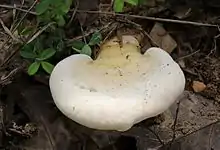Ganoderma curtisii
Ganoderma curtisii is a wood-decaying polypore whose distribution is primarily in the Southeastern United States.[2][3] Craig and Levetin claim to have observed it in Oklahoma.[4]
| Ganoderma curtisii | |
|---|---|
 | |
| Scientific classification | |
| Kingdom: | |
| Division: | |
| Class: | |
| Order: | |
| Family: | |
| Genus: | |
| Species: | G. curtisii |
| Binomial name | |
| Ganoderma curtisii | |
| Synonyms[1] | |
|
Polyporus curtisii Berk. (1849) | |
| Ganoderma curtisii | |
|---|---|
float | |
| pores on hymenium | |
| cap is offset | |
| hymenium is decurrent or subdecurrent | |
| stipe is bare | |
| spore print is brown | |
| ecology is saprotrophic | |
| edibility: inedible | |
Taxonomic history
The name was originally established by Miles Berkeley in 1849 as Polyporus curtisii, and later transferred to the genus Ganoderma by William Alphonso Murrill in 1908. This species is tentative and is a subject of debate as to its viability as a distinct species from North American specimens described as G. lucidum (G. sessile), which is much more widely distributed throughout the US. There is also debate about the identities of several species that resemble G. lucidum and G. tsugae.
One reason for an alleged synonymy between G. sessile and G. curtisii is overlap in habitat, decaying hardwoods. According to Volk, Gilbertson and Ryvarden, authors of North American Polypores, it is not considered a separate species from G. lucidum. Bessette et al., authors of Mushrooms of the Southeastern United States, echo this and list it as a synonym to G. lucidum.[5] Paul Stamets considers G. lucidum and G. curtisii to both be members of a tight-knit species complex.[6]
However, several recent molecular studies have shown Ganoderma curtisii to be genetically distinct from Ganoderma lucidum, calling into doubt the synonymy of the two species and supporting previous mycologists' opinion that it is a distinct species.[7][8][9] The same studies support the idea that G. lucidum sensu stricto is actually absent from the North American continent and that the mushroom widely called G.lucidum in North America is instead G.sessile, a member of the Ganoderma resinaceum complex, with Ganoderma curtisii as a separate species.
Description
This polypore bears a marked resemblance to G. lucidum and generally has a stipe, sometimes lacking the characteristic red to purple varnished appearance that G. lucidum possesses. The flesh is spongy in pore tissue and firm in the stipe. The pores bruise brown when damaged.
Its habitat of choice is decaying stumps and roots of hardwoods, which aligns perfectly with that of G. sessile.
References
- "Ganoderma curtisii (Berk.) Murrill 1908". MycoBank. International Mycological Association. Retrieved 2011-12-23.
- Coutler, John (1908) Botanical Gazette, University of Chicago Press, p. 336.
- Volk, Tom, Engelbrecht, Kathleen, "Tom Volk's Fungus of the Month", Ganoderma lucidum
- Craig, Rebekah; Levetin, Estelle (2000). "Multi Year Study of Ganoderma Biology" (PDF). Aerobiologia. 16: 75–81. doi:10.1023/A:1007682600175. S2CID 31860024.
- Bessette, Alan; Bessette, Arleen; William, Roody; Dunway, Dail (2007) [1st. Pub. 2007]. Mushrooms of the Southeastern United States. Syracuse University Press. p. 254.
- Stamets, Paul (2005). Mycelium Running. Ten Speed Press. p. 228. ISBN 978-1-58008-579-3.
- Zhou, Li-Wei; Cao, Yun; Wu, Sheng-Hua; Vlasák, Josef; Li, De-Wei; Li, Meng-Jie; Dai, Yu-Cheng (25 October 2015). "Global diversity of the Ganoderma lucidum complex (Ganodermataceae, Polyporales) inferred from morphology and multilocus phylogeny". Phytochemistry. 114: 7–15. doi:10.1016/j.phytochem.2014.09.023. PMID 25453909. Retrieved 23 September 2018 – via ResearchGate.
- Cao, Yun; Wu, Sheng-Hua; Dai, Yu-Cheng (2012). "Species clarification of the prize medicinal Ganoderma mushroom "Lingzhi"". Fungal Diversity. 56: 49–62. doi:10.1007/s13225-012-0178-5. S2CID 15239238.
- Yang, Zhu L.; Feng, Bang (March 2013). "What is the Chinese "Lingzhi"? – a taxonomic mini-review". Mycology. 4 (1): 1–4. doi:10.1080/21501203.2013.774299 (inactive 2021-01-11).CS1 maint: DOI inactive as of January 2021 (link)
External links
- G. curtisii – Images at Mushroom Observer